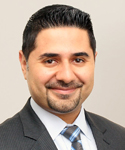Chairing the ACR’s Communications and Marketing Committee (CMC) can be a monumental task: The CMC is responsible for both internal and external communications to a variety of people, including rheumatology providers, patients, lawmakers, the pharmaceutical industry and others. But the CMC’s newest chair, Suleman Bhana, MD, FACR, is up for the job. The Rheumatologist recently caught up with Dr. Bhana, a rheumatologist in a multispecialty practice in New York state, to learn more about him and his work on the CMC.
The Rheumatologist: How did you get involved in ACR leadership?
Dr. Bhana: Back when I was a fellow in 2011, I was using Twitter to try to increase rheumatologists’ engagement. I started a rheumatology podcast with some other rheumatologists, and we would focus on journal articles, new guidelines in the field, and technology topics, like tech products to help in the office or home. About four or five years ago, I was invited to give talks on tech tools in rheumatology, and that helped me get a foot in the door. About three years ago, some members of the CMC were rotating out, and Kelly Weselman, MD, FACR, now-outgoing chair, was looking to bring in younger, more tech-savvy members who were versed in social media. Every door opens up a different door, and last year, when I was waiting for my son in Kumon class, Kelly and I talked about me taking the leadership role, and I accepted the position.
TR: What are some of the projects you have been part of on the CMC?
Dr. Bhana: We did a lot of revamping to the patient section of the ACR website. We created one-page fact sheets that are more digestible and at a better reading level. It was a huge undertaking. We also worked on the Spanish-language translations of the patient fact sheets; we get a lot of hits from patients and providers in Latin America. We also worked on the Rheumatic Disease Awareness Month campaign. For the past two years, Terry Bradshaw has been our spokesperson, and it was huge to find someone who has rheumatic disease, has broad appeal and whose rates we can afford. Hopefully, we can keep working with him.
TR: Speaking of hope, what are some of your goals as CMC chair?
Dr. Bhana: I want to make it a forum, an atmosphere that brings smart people together to brainstorm about the needs of the community and the College, and how the committee can be part of ongoing endeavors. I hope to bring forward the state scorecards to improve patient access, which was a coordinated effort with the Education Committee and the political committees [Government Affairs and RheumPAC] that laid the groundwork for understanding, state by state, what patients are experiencing. I hope to continue working on the workforce shortage in rheumatology and think about how to get people to train in rheumatology. I also hope to focus on patient advocacy. I look forward to what the other committee members have to say. I think the trend the past few years—and hopefully I can keep pushing for this—is not having each committee siloed, and maybe we can have more coordinated efforts on projects between several committees and take a more holistic approach.
TR: How did you get interested in rheumatology?
Dr. Bhana: I knew I wanted to do an internal medicine subspecialty once I graduated from medical school. I had good experiences with rheumatology when I was a student; they were nice and smart people. I was also more familiar with the field because my mom has psoriatic arthritis and my grandmother had discoid lupus. After medical school, I thought I would go into gastroenterology, but I always saw patients in the hospital at 2 and 3 a.m. I think I had PTSD from my father, who is a psychiatrist and would get called out in the middle of the night. I knew I didn’t want to do that to my family or have the stress of it. I like the science and practice of rheumatology, and I also get to have a life, spend time with my family and do recreation. I do hope that through the ACR and other organizations, payers and lawmakers begin to understand the importance of better reimbursing and incentivizing cognitive specialties like ours.
TR: Have you found that balance? What do you like to do outside of work?
Dr. Bhana: Not as much. I put a lot of extra stuff on my plate—like scraping butter over too much bread (sorry, that’s a Lord of the Rings reference; I’m a huge nerd). But I still come home and see my kids every night, put them to bed and play with them on weekends. My kids are 9 and 4, two boys, and my wife says it’s not fair that I get to relive my childhood through them. My parents saved my old Star Wars, Voltron and Transformer toys, so after all these years, and now that my kids are older, I got to break out the boxes [with these toys], and we play with them. We also like to travel—we have family in several areas, and we go to Manhattan quite a bit for museums and restaurants and jazz clubs. We take advantage of the city as much as we can without living in it.
Kelly April Tyrrell writes about health, science and health policy. She lives in Madison, Wis.


